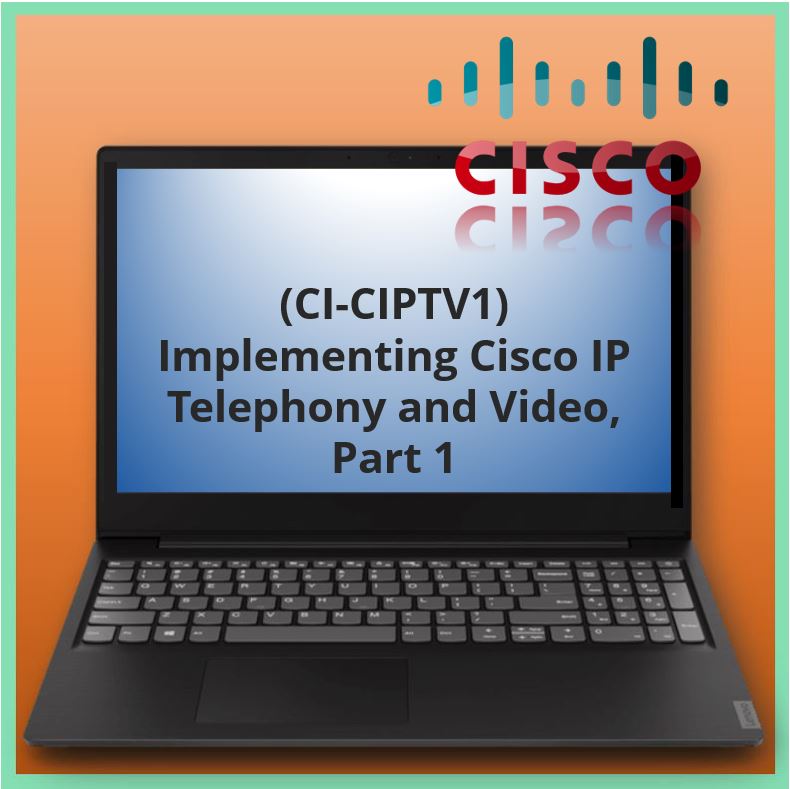Aangeboden leervormen

Implementing Cisco IP Telephony and Video, Part 1 (CI-CIPTV1)
Implementing Cisco IP Telephony & Video, Part 1 (CIPTV1) v1.0 is a course that prepares the learner for implementing a Cisco Collaboration solution at a single-site environment. This course focuses primarily on Cisco Unified Communications Manager Version 10.x, which is the call-routing and signaling component for the Cisco Collaboration solution.
Lab exercises included in the course help learners to perform postinstallation tasks, configure Cisco Unified Communications Manager, implement MGCP and H.323 and, SIP trunks, and build dial plans to place single site on-cluster and off-cluster calling for voice and video. Learners will also implement media resources, audio and video conferencing, and describe QoS.
By the end of this course, you should be able to:
Describe the role of Cisco Unified Communications Manager in a Cisco Collaboration Solution, including its functions, architecture, deployment, and redundancy options, and how to deploy endpoints, users, and Cisco IP Phone Services.
Describe the functions and the purpose of a dial plan and explains how to implement on-cluster calling
Describe how to configure MGCP, H.323, and SIP gateways. The module also describes how to create a dial plan that supports inbound and outbound off-cluster calling for numbers and URLs.
Describe the types of media resources that Cisco Unified Communications Manager supports, how to configure Cisco Unified Communications Manager server software-based media resources, and how to implement Cisco hardware-based media resources
Describe how to implement audio and video conferencing devices that can be used with Cisco Unified Communications Manager, built-in Cisco Unified Communications Manager software audio bridge, Cisco IOS-based audio and video conference bridges, and Cisco TelePresence conferencing products including Cisco TelePresence MSE 8000, Cisco TelePresence Server, Cisco TelePresence MCU, and Cisco TelePresence Conductor.
Provide an introduction to QoS with emphasis on the QoS components, often referred to as the QoS toolkit, that are used to provide services for various business applications.
Voor wie
The primary target audiences for the course are:
• Network administrators and network engineers
• CCNP Collaboration candidates
Secondary audiences are:
• Systems engineers
Programma
Module 1: Cisco Unified Communications Manager Introduction
• Overview of the Cisco Collaboration Solution
• Cisco Unified Communications Manager Functions
• Cisco Unified Communications Manager Architecture
• Cisco Unified Communications Manager Models
• Cisco Unified Communications Manager Redundancy
• Cisco Unified Communications Manager Servers
• Cisco Unified Communications Manager Services
• Cisco Unified Communications Manager Groups
• Cisco Unified Communications Manager Configuration Elements: Enterprise Parameters
• Cisco Unified Communications Manager Configuration Elements: Service Parameters
• Cisco Unified Communications Manager Configuration Elements: Device Settings
• Comparison of Endpoints Supported by Cisco Unified Communications Manager
• Endpoint Configuration Elements
• Cisco Unified Communications Manager User Accounts
• Types of LDAP Integration: Synchronization
• Types of LDAP Integration: Authentication
• LDAP Integration Features: Attribute Mapping
• LDAP Integration Feature: Filters
• Overview of Cisco IP Phone Services
• Cisco IP Phone Services: Deployment Options
Module 2: Dial Plan Introduction and Implementation of Single-Site On-Cluster Calling
• Dial Plan Overview
• Dial Plan Components and Their Functions
• Comparison of Dial Plan Configuration Elements
• Endpoint Addressing
• Cisco Unified Communications Manager Call Routing Overview
• Cisco Unified Communications Call-Routing Logic
• Addressing Methods and Digit Analysis
• Variable-Length Patterns, Overlapping Patterns, and Urgent Priority
• Calling Privileges Overview
• Calling-Privileges Configuration Elements
• Partitions and CSSs
• Partition and CSS Considerations
• Partition and CSS Configuration
• Call Coverage Overview
• Call Hunting
• Call Hunting Scenarios
• Call Queuing
• Call Hunting and Call Queuing Configuration
Module 3: Implementation of Single-Site Off-Cluster Calling
• PSTN Access Methods
• TDM Gateway vs. Cisco UBE
• TDM Gateway Comparison
• Audio and Video Codec Selection
• PSTN Numbering Plans
• MGCP Gateway Implementation Overview
• MGCP Gateway Support in Cisco Unified Communications Manager
• MGCP Gateway Implementation Considerations
• Implement an MGCP Gateway in Cisco Unified Communications Manager
• Integrate Cisco IOS MGCP Gateways with Cisco Unified Communications Manager
• Configure Cisco IOS MGCP Gateway Fractional PRIs
• Path Selection in Cisco Unified Communications Manager
• Route Groups in Cisco Unified Communications Manager
• Route Lists in Cisco Unified Communications Manager
• Digit Manipulation Requirements with Multiple Paths
• Digit Manipulation Configuration Elements in Cisco Unified Communications Manager
• PSTN Access Digit Manipulation Example
• H.323 and SIP Gateway Overview
• Dial Peer Overview
• Inbound Dial Peer Selection
• Discovery 1: Exploring Cisco IOS Gateway Functions
• Outbound Dial Peer Selection
• Discovery 2: Exploring Cisco IOS Gateway Functions
• Digit Manipulation Features
• Codec Configuration
• COR Configuration
• H.323 PSTN Gateway Configuration in Cisco Unified Communications Manager Deployments
• Dial Plan Design and Documentation
• Cisco Unified Border Element Overview
• Protocol Interworking on the Cisco Unified Border Element
• Media Flows on the Cisco Unified Border Element
• Codec Negotiation on the Cisco Unified Border Element
• PSTN SIP Access Overview
• Configuration Requirements in Cisco Unified Communications Manager
• Configuration Requirements for the Cisco Unified Border Element
• Cisco Unified Border Element URI Dialing Overview
• Cisco Unified Communications Manager URI Dialing Configuration Requirements
• Cisco Unified Border Element URI Dialing Configuration Requirements
• Dial Plan Interworking Characteristics
• Dial Plan Interworking Support
Module 4: Media Resources
• Media Resources Overview
• Audio Conferences
• Video Conferences
• Transcoders
• Media Termination Points
• Annunciators
• Music on Hold
• Video on Hold
• Trusted Relay Points
• MOH Support in Cisco Unified Communications Manager
• Unicast and Multicast MOH Characteristics
• MOH Audio Source Selection
• MOH Configuration
• Annunciator Support in Cisco Unified Communications Manager
• Annunciator Configuration Procedure
• Media Resource Access Control Overview
• Conference Bridge Selection
• Media Resource Access Control Configuration
• MTP Types and Functions
• MTP Requirements for SIP Trunks
• MTP Requirements for H.323
• MTP Configuration Procedure
Module 5: Audio and Video Conferencing
• Devices That Support Audio or Video Conferencing
• Comparison of Audio Conference Bridges
• Comparison of Video Conference Bridges
• Conference Bridge Integration Options in Cisco Unified Communications Manager
• Cisco Unified Communications Manager Software Audio Conference Bridge
• Cisco IOS-based Conference Bridges
• Cisco Unified Communications Manager- and Cisco IOS-based Conference Bridge Configuration
• Cisco TelePresence MSE 8000 Overview
• Cisco TelePresence MSE 8000 Feature Blades
• Cisco TelePresence MSE 8000 Capabilities
• Cisco TelePresence MSE 8000 Feature Blade Configuration
• Cisco TelePresence Server Overview
• Integration of Cisco TelePresence Server and Cisco Unified Communications Manager
• Configuration Example of Cisco TelePresence Server Integration
• Cisco TelePresence Conductor Characteristics
• Options for Integrating Cisco TelePresence Conferencing Resources
• Integration of Cisco TelePresence Conductor and Cisco Unified Communications Manager
Module 6: Quality of Service
• Issues in Packet-Switching Networks
• Solutions to Packet-Switching Network Issues
• Bandwidth Calculations
• Bandwidth Calculations for Layer 2 Overhead
• Bandwidth Calculations for Video Calls
• Three Models of QoS: Best-Effort
• Three Models of QoS: IntServ
• Resource Reservation Protocol
• Three Models of QoS: DiffServ
• Differentiated Services Code Point
• Overview of QoS Components
• Classification
• Marking
• Mapping Classes and Markings
• Congestion Management
• Congestion Avoidance
• Policing
• Shaping
• Link Efficiency Methods: Compression
• Link Efficiency Methods: LFI
• Marking Methods
• Class-Based Markings
• Trust Boundaries
• Mapping Layer 2 CoS to Layer 3 QoS
• Marking Configuration Example
• Comparison of Policing and Shaping
• Class-Based Policing: Single Bucket
• Class-Based Policing: Dual Buckets
• Class-Based Policing: Dual Rate
• Class-Based Shaping
• Low Latency Queuing
• Monitoring LLQ
• Calculating Bandwidth for LLQ
• Example 1: Single-Rate Single Token Bucket Class-Based Policing
• Example 2: Single-Rate Dual Token Buckets Class-Based Policing
• Example 3: Class-Based Shaping
Labs
• Configuring Cisco Unified Communications Manager Initial Settings
• Deploying Endpoints and Users
• Implementing Endpoint Addressing and Call Routing
• Implementing Calling Privileges
• Implementing Call Coverage
• Implementing PSTN Calling Using MGCP Gateways
• Implementing PSTN Calling Using H.323 Gateways
• Implementing PSTN Calling Using SIP Trunks Through Cisco Unified Border Element
• Using Cisco Unified Border Element for URI Dialing
• Implementing Annunciators and MOH
• Implementing Conference Bridges
• Implementing Cisco TelePresence Conductor
Voorkennis
The knowledge and skills that a learner must have before attending this course are as follows:
• Working knowledge of fundamental terms and concepts of computer networking, including LANs, WANs, switching and routing
• Ability to configure and operate Cisco routers and switches and to enable VLANs and DHCP
• Basics of digital interfaces, PSTN, and VoIP
• Fundamental knowledge of converged voice and data networks
Attending the following courses would be recommended:
• Implementing Cisco Collaboration Devices (CICD)
• Implementing Cisco IP Telephony & Video, Part 1 (CIPTV1)
• Implementing Cisco IP Telephony & Video, Part 2 (CIPTV2)
Examen
This course is part of the following Certifications:
• Cisco Certified Network Professional Collaboration (CCNP)
Duur training
Blended learning: 3 dagen


 NIMA Sales A versneld in een Blended Learning variant
NIMA Sales A versneld in een Blended Learning variant 




